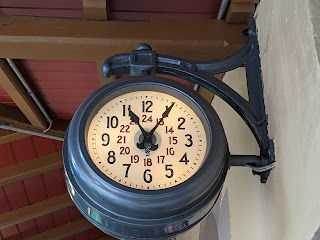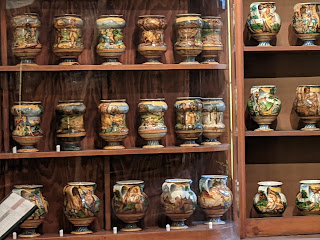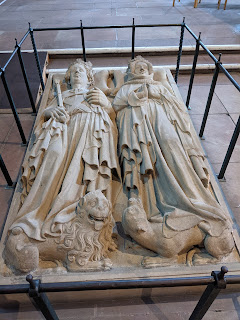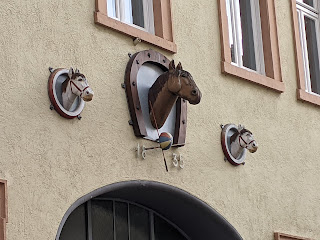Instead of spending another day seeing more sights in Frankfurt, Steven and I took a train to Heidelberg just 45 minutes south of the city. Reading that Heidelberg was one of the most romantic cities in Germany, thanks to its picturesque riverside location, its beautiful old buildings, and bridges, and the castle ruins that overlook the town center was enough reason for us to visit for a day!
This Daily Travelogue is a labor of love for our families and friends at home and around the world. Prior to 2020, all our trips were documented on separate, yearly blogs which can be accessed below. Remember that clicking on any picture will open it for better viewing. Also, please consider adding your name at the end of any comments. Be safe, stay healthy, and stay connected.
Monday, October 18, 2021
9/29/21: Day Trip to Heidelberg from Frankfurt
The very colorful train station:
The view of all the bikes at the train station reminded us of similar sights in Belgium's larger cities.
As the weather was worsening by the moment, we decided to head directly up to Heidelberg Castle to get the best possible views of the city while we could. What better way than taking a funicular from the center of the Old Town? First, though, we had to fill out detailed Covid forms, and exchange our cloth masks for disposable ones that we luckily had with us as only they were allowed. That was certainly a first for us.
Far below were great views of the city that spanned the Neckar River.
Even though Steven and I would never describe ourselves as train buffs, having a chance to ride a 100-year-old cable car to the top of a mountain in Germany isn't an experience we'd likely pass up very often!
Halfway up the mountain, we transferred to the Bergbahn, a historic funicular railway.
I was lucky to get seats right in front so was able to capture this photo of another funicular barreling toward us heading down the mountain.
It was neat taking a lower funicular from the Kornmarkt station in the Old Town and then continuing on the older funicular up to the Konigstuhl station with its spectacular views. Konigsthuhl was located 1,804 feet above sea level and 1,436 feet above Heidelberg itself.
The temperature had dropped considerably by the time we reached the mountain top so we didn't do any hiking up there as we had hoped to do.
Nicholas Riggenbach, a Swiss engineer, was given the responsibility of planning the rack-and-pinion railway from the valley station up to the castle and beyond in 1873. The first plans were produced in 1882 for a combination of funicular and rack-and-pinion railway in Heidelberg.
In 1905, the ground-breaking ceremony for upper funicular's construction was held.
In 2004, about a hundred years later, the Heidelberg funicular railways were recognized as having particular, historic, cultural importance.
Down we went at just five kilometers per hour toward the castle stop at Molkenkur!
Before buying entrance tickets to the castle, we again had to fill out another set of Covid emergency contact forms. I was told the forms would be kept for two weeks in case anybody later tested positive for Covid so that anyone entering the premises about the same time could be contacted. An employee half-jokingly said it was another example of German bureaucracy!
The 16th-century castle, built of red Neckar sandstone about 600 feet on the terraced hillside above Old Town, was described as one of the best examples of German Renaissance architecture. After the Palatinate region was destroyed by the French in the 17th century, the castle has remained the largest and most picturesque ruin in Germany. There were all sorts of cute animals decorating the Elizabeth Gate to the castle.
The Torturm was a 40-meter-high tower built from 1531-41 to safeguard the main entrance. It included a dungeon and rooms for defense. After the original roof burned down in 1689, it was reconstructed in 1718.
Ruprechtsbau, the dwelling of Elector Ruprechts III, 1398-1410, was the oldest building on the castle grounds.
Bibliotheksbau, the Elector's private library, was partially built on the old embankment walls around 1528-40. It originally had murals and archives on the ground floor with the library hall on the upper floor.
Even though it was but a shell of its former self, it was still striking.
One of the few places we could enter in the castle was the Pharmacy Museum.
The 18th-century pharmacist's shop night bell was an example of how pharmacists, since the beginning of organized pharmacy (in Germany only, I wondered?) were obliged by their oath to render medication to anyone who needed it at any hour of the day. At the beginning of the 20th century, that obligation for each pharmacist changed to a rotation of alternating pharmacies.
After the St. Ursula Convent in Klagenfurt was destroyed by lightning and fire in 1728, it was reconstructed with a pharmacy two years later. The pharmacy was required for the convent's nursing requirements and also for the population of the neighboring villages.
As only the Ursuline sisters had access to the convent, all medications had to be dispersed to others via the convent's entrance. Obviously only an Ursuline nun was allowed to work in the pharmacy office even though women hadn't been allowed to train as pharmacists until the 20th century. The only way around that was having a nun experienced in the art of healing passed on her knowledge to a novice who later helped the next generation. There were certificates, though, showing that some women were trained in pharmacists' shops but only if they accepted the choice of convent life.
When the convent's pharmacy was dissolved in 1924, there were still two educated pharmacists in the order. They used the pharmacy rooms for the convent's needs until 1940. During the war, the buildings were confiscated and the pharmacy was closed in 1953 but became part of the Pharmacy Museum.
Originally, all drawers had painted labels for their contents rather than the metal plates. The 19th-century scale on the prescription table was decorated with a gilded figure of Christ which wouldn't have been out-of-place in the convent.
Never would I have expected a convent to have had such an attractive pharmacy. I think it took us both by surprise that it wasn't far plainer.
Adjacent rooms in the museum had lovely 17th- and 18th-century Italian majolica medicine jars that were decorated with multicolored floral designs and were like works of art. Rarely were pharmaceutical or medical topics depicted on pharmaceutical vessels.
I hadn't realized that since classical antiquity, oriental drugs were an important part of any pharmacy beside the native ones. Long and risky travel across land and sea made the former drugs very expensive. During the late Middle Ages and the early modern age, German pharmacies purchased foreign medications through trading partners or at trade fairs held twice yearly in Frankfurt, Leipzig, Hamburg, or Antwerp.
At one time, the wine barrels in the Heidelberg Castle cellar would have been full of wine from the nearby area. This enormous barrel from 1751 was evidence of the Palatinate region's historical wine culture. Its 58,000-gallon capacity made it the largest wooden barrel ever to be filled with wine on the planet!
From the palace's courtyard, we had stunning panoramic views of Heidelberg.
A lovely view of the Karl Theodor Bridge that we'd explore later.
Though there hadn't been a lot to view at the castle, it was an enjoyable sight, and the views alone were worth the hefty price of getting there and of admission.
Since we'd caught glimpses of Old Town from above the city, we returned to Kornmarkt square that had been a bustling grain market in the Middle Ages before it was home to a Catholic hospital in the 16th-century. We could see the layout of the hospital’s chapel by the paving in the square. In the top left, you can spot Heidelberg Castle on the slopes above the Kornmarkt.
In the 17th-century, a statue known as Madonna at the Grain Market was built in the square as part of a Jesuit campaign designed to promote Catholicism. The statue is regarded now as a fine work of art that provides the perfect centerpiece to a pleasant town square.
Just steps away from Kornmarkt was Marktplatz or Market Square, the most important square in Heidelberg as it was where the medieval market was held centuries ago. Dominating the pretty square was The Church of the Holy Spirit whose foundations were laid in 1398, but it wasn't until 1544 that the tower was completed. The current tower was built in 1709 after the church had been set on fire by the French in the War of the Palatine Succession.
Depending on whom and what you read and believe, the church was an example of early ecumenism, or at least of peaceful co-existence between Catholics and Protestants, each of whom used it, and often at the same time. In 1706, a partition was built so each could hold services simultaneously. After the wall was removed in 1936, the church became exclusively Protestant.
Uniting both knowledge and faith, the acclaimed University of Heidelberg was established in 1386 in a building that predated this church. The church was also used not just for services but as a lecture hall for the university. The world-famous Biblioteca Palatina, one of the biggest libraries in Western Europe was located in the church until thieves stole the books in 1623.
In the center of Marktplatz was a statue of Hercules.
Also on Marktplatz was City Hall.
The square led to Hauptstrasse, a narrow pedestrian street that was fun to walk along and look at medieval architecture, shops, galleries, cafés, and restaurants. We didn't know whether the buildings were indeed original medieval architecture or, like Frankfurt's all recreated because of their being destroyed in the war. Whatever the case, it was delightful and very picturesque.
I am sure that in warmer weather the cafes and restaurants would have spilled over with people enjoying beer or coffee but on that chilly and damp late September day, no one wanted to be outside drinking!
It would have been hard to imagine a prettier street than this in a German town in our minds.
Just visible ahead were the white towers of the entrance gate to the Old Town with
its Karl Theodor Bridge that we'd first spotted from the castle.
Also known as the Old Bridge, Heidelberg's spectacular Karl Theodor Bridge has been immortalized in numerous poems and paintings. Spanning the Neckar River and joining the two sides of historic Heidelberg, the famous bridge was named after the man who designed and built its nine red sandstone arches in 1788 as a replacement for the numerous wooden bridges that preceded the stone bridge.
For some reason known only to locals, there was a monkey statue on the bridge!
After crossing over to the other side of the river, we had visions of strolling along Philosophenweg or Philosophers' Way that ran along the side of Heiligenberg or Saints' Mountain, high above Heidelberg. It was where the university's philosophers would walk and carry on discussions as they admired the scenery.
If the weather had been a lot warmer and drier, I think the romantic walk would have been right up our alley but we only got a few yards in before deciding the walk wasn't for us that day.
Macaroons, anyone?!
The only thing I really knew about Heidelberg before we decided to visit was its very famous university. According to Wikipedia 56, Nobel Laureates have had some connection with the University of Heidelberg, and 9 of them received the Nobel Prize while they were working there. I suggested to Steven we visit the university so we took the bus out to what we discovered was the new university area north of the city.
Unfortunately, we hadn't researched where the main or old campus was ahead of time so we ended up so turning around and walking back a good distance before finally getting a tram back to the Old Town! There, all along was the heart of the University of Heidelberg. All I could think of was our being on an episode of The Amazing Race and being eliminated because we hadn't followed directions, Suellen!
Knowing it closed at 4, we walked very quickly to Peterskirche or St. Peter's Church, the city's oldest parish church that dated to 1196. It became the university church in 1836 but close relations between the church and university dated to the 14th-century.
We were relieved to arrive with enough time to spend in the church as we didn't see anything else related to the old university buildings!
The sumptuous but undated painting depicted Christ and Mary Magdalene.
Peter Walking on Water was painted in 1902.
The huge organ loft dated to 1911.
On the side walls were gravestone slabs from the 16th-century onwards.
New stained-glass windows were added in 2005-6. This one depicted Martin Luther, the German theology professor best known for his role in the Protestant Reformation and as the namesake of Lutheranism.
The Neo-Gothic pulpit was created in 1870.
In the University Chapel was a book that listed expelled professors but there was no reference from what period or what crimes had been committed.
As a Catholic, it was unusual seeing a chapel in a centuries-old church where the images were the same height and also so simple.
Another chapel was similarly plain but it had chairs that could be moved about for quiet reflection or prayer.
Even though the weather hadn't been the best, our day trip to Heidelberg had been a lot of fun and gave us a chance to see the vibrant university city with its pretty squares, stone bridge, and castle via the funicular trains. Thanks to some great timing with the tram and the train back to Frankfurt, we were 'home' by 6:30.
Next post: On to Zurich for Steven's first chance to visit Switzerland.
Posted on October 18th, 2021, on our last night in Vernazza, one of the scenic Cinque Terre towns in northern Italy.
Labels:
Germany
Subscribe to:
Post Comments (Atom)



















































































































Hi Annie, thank you for this. How beautiful!
ReplyDeleteDo you remember Dad singing "funiculi, funicula?" https://www.youtube.com/watch?v=XW0W7j04iRQ
That may have been something reserved for the older kids in bed-room singalongs :(
Big hug!
Andrew,
ReplyDeleteThanks for dredging up that long ago memory as I had forgotten it until I listened to the YouTube link!